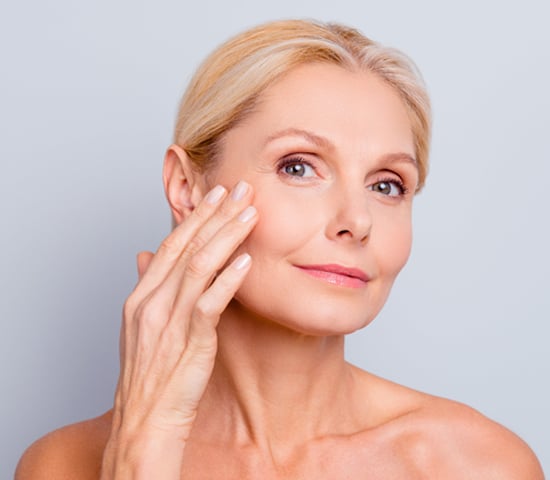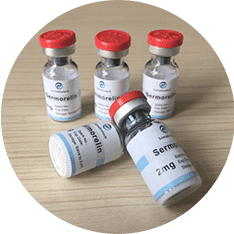
Unlock a More Youthful You With Hormone Replacemment Therapy In Delaware Park, NJ
Aging is inevitable, and for many, it signals the beginning of a new chapter - one where you cross off bucket list items and live life to the fullest, on your own terms. However, for some women, aging is a horrible prospect, filled with chronic fatigue, irritability, and inability to perform in the bedroom. If you're concerned about life in middle age and beyond, we've got great news: there are easy, proven steps that you can take to help stop the negative effect of aging.
Global Life Rejuvenation was founded to give women a new lease on life - one that includes less body fat, fewer mood swings, and more energy as you age. If you're ready to look and feel younger, it's time to consider HRT (hormone replacement therapy), and growth hormone peptides. These therapies for men and women are effective, safe, and customized to fit your goals, so you can keep loving life as you get older.
HRT, and growth hormone peptide therapies bridge the gap between your old life and the more vibrant, happier version of you. With a simple click or call, you can be well on your way to a brighter future. After all, you deserve to be the one in charge of your wellness and health. Now, you have the tools to do so - backed by science and applied by our team of HRT experts with more than 13 years of experience.
What is HRT?
As women age, their hormones begin to go through changes that affect their day-to-day lives. For women, hormone deficiency and imbalance usually occur during menopause and can cause chronic fatigue, hot flashes, and mood swings, among other issues. Hormone replacement therapy helps correct hormone imbalances in women, helping them feel more vibrant and virile as they age.
Often, HRT treatments give patients enhanced quality of life that they didn't think was possible - even in their 60's and beyond.
The benefits for women are numerous and are available today through Global Life Rejuvenation.
HORMONE REPLACEMENT THERAPY
HRT and Anti-Aging Medicine for Women in Delaware Park, NJ
As women age, their bodies begin to go through significant changes that affect their quality of life. This change is called menopause and marks the end of a woman's menstrual cycle and reproduction ability. Though there is no specific age when this change occurs, the average age of menopause onset is 51 years old. However, according to doctors, menopause officially starts 12 months after a woman's final period. During the transition to menopause, women's estrogen and other hormones begin to deplete.
As that happens, many women experience severe symptoms. These symptoms include:
- Hot Flashes
- Chronic Fatigue
- Incontinence
- Trouble Sleeping
- Dryness
- Muscle Loss
- Fat Gain
- Mood Swings
The symptoms of hormone deficiency can be concerning and scary for both women and their spouses. However, if you're getting older and notice some of these symptoms, there is reason to be hopeful. Hormone replacement therapy and anti-aging medicine for women can correct imbalances that happen during menopause. These safe, effective treatments leave you feeling younger, healthier, and more vibrant.


What Causes Menopause?
The most common reason for menopause is the natural decline in a female's reproductive hormones. However, menopause can also result from the following situations:
Oophorectomy: This surgery, which removes a woman's ovaries, causes immediate menopause. Symptoms and signs of menopause in this situation can be severe, as the hormonal changes happen abruptly.
Chemotherapy: Cancer treatments like chemotherapy can induce menopause quickly, causing symptoms to appear shortly after or even during treatment.
Ovarian Insufficiency: Also called premature ovarian failure, this condition is essentially premature menopause. It happens when a woman's ovaries quit functioning before the age of 40 and can stem from genetic factors and disease. Only 1% of women suffer from premature menopause, but HRT can help protect the heart, brain, and bones.
Common Issues for Women During Menopause
For many women, menopause is a trying time that can be filled with many hormonal hurdles to jump through. A little knowledge can go a long way, whether you're going through menopause now or are approaching "that" age.
Here are some of the most common issues that women experience during menopause:

Depression
If you're a woman going through menopause and find that you have become increasingly depressed, you're not alone. It's estimated that 15% of women experience depression to some degree while going through menopause. What many women don't know is that depression can start during perimenopause, or the years leading up to menopause.
Depression can be hard to diagnose, especially during perimenopause and menopause. However, if you notice the following signs, it might be time to speak with a physician:
- Mood Swings
- Inappropriate Guilt
- Chronic Fatigue
- Too Much or Too Little Sleep
- Lack of Interest in Life
- Overwhelming Feelings
Remember, if you're experiencing depression, you're not weak or broken - you're going through a very regular emotional experience. The good news is that with proper treatment from your doctor, depression isn't a death sentence. And with HRT and anti-aging treatment for women, depression could be the catalyst you need to enjoy a new lease on life.

Hot Flashes
Hot flashes - they're one of the most well-known symptoms of menopause. Hot flashes are intense, sudden feelings of heat across a woman's upper body. Some last second, while others last minutes, making them incredibly inconvenient and uncomfortable for most women.
Symptoms of hot flashes include:
- Sudden, Overwhelming Feeling of Heat
- Anxiety
- High Heart Rate
- Headache
- Nausea
- Dizziness
Typically, hot flashes are caused by a lack of estrogen. Low estrogen levels negatively affect a woman's hypothalamus, the part of the brain that controls body temperature and appetite. Low estrogen levels cause the hypothalamus to incorrectly assume the body is too hot, dilating blood vessels to increase blood flow. Luckily, most women don't have to settle for the uncomfortable feelings that hot flashes cause. HRT treatments for women often stabilize hormones, lessening the effects of hot flashes and menopause in general.

Mood Swings
Mood swings are common occurrences for most people - quick shifts from happy to angry and back again, triggered by a specific event. And while many people experience mood swings, they are particularly common for women going through menopause. That's because, during menopause, the female's hormones are often imbalanced. Hormone imbalances and mood swings go hand-in-hand, resulting in frequent mood changes and even symptoms like insomnia.
The rate of production of estrogen, a hormone that fluctuates during menopause, largely determines the rate of production the hormone serotonin, which regulates mood, causing mood swings.
Luckily, HRT and anti-aging treatments in Delaware Park, NJ for women work wonders for mood swings by regulating hormone levels like estrogen. With normal hormone levels, women around the world are now learning that they don't have to settle for mood swings during menopause.

Weight Gain
Staying fit and healthy is hard for anyone living in modern America. However, for women with hormone imbalances during perimenopause or menopause, weight gain is even more serious. Luckily, HRT treatments for women coupled with a physician-led diet can help keep weight in check. But which hormones need to be regulated?
- Estrogen: During menopause, estrogen levels are depleted. As such, the body must search for other sources of estrogen. Because estrogen is stored in fat, your body believes it should increase fat production during menopause. Estrogen also plays a big part in insulin resistance, which can make it even harder to lose weight and keep it off.
- Progesterone: Progesterone levels are also depleted during menopause. Progesterone depletion causes bloating and water retention, while loss of testosterone limits the body's ability to burn calories.
- Ongoing Stress: Stress makes our bodies think that food is hard to come by, putting our bodies in "survival mode". When this happens, cortisol production is altered. When cortisol timing changes, the energy in the bloodstream is diverted toward making fat. With chronic stress, this process repeatedly happens, causing extensive weight gain during menopause.

Low Libido
Lowered sexual desire - three words most men and women hate to hear. Unfortunately, for many women in perimenopausal and menopausal states, it's just a reality of life. Thankfully, today, HRT and anti-aging treatments Delaware Park, NJ can help women maintain a normal, healthy sex drive. But what causes low libido in women, especially as they get older?
The hormones responsible for low libido in women are progesterone, estrogen, and testosterone.
Progesterone production decreases during perimenopause, causing low sex drive in women. Lower progesterone production can also cause chronic fatigue, weight gain, and other symptoms. On the other hand, lower estrogen levels during menopause lead to vaginal dryness and even vaginal atrophy or loss of muscle tension.
Lastly, testosterone plays a role in lowered libido. And while testosterone is often grouped as a male hormone, it contributes to important health and regulatory functionality in women. A woman's testosterone serves to heighten sexual responses and enhances orgasms. When the ovaries are unable to produce sufficient levels of testosterone, it often results in a lowered sex drive.

Vaginal Dryness
Often uncomfortable and even painful, vaginal dryness is a serious problem for sexually active women. However, like hair loss in males, vaginal dryness is very common - almost 50% of women suffer from it during menopause.
Getting older is just a part of life, but that doesn't mean you have to settle for the side effects. HRT and anti-aging treatments for women correct vaginal dryness by re-balancing estrogen, progesterone, and testosterone. When supplemented with diet and healthy living, your vagina's secretions are normalized, causing discomfort to recede.

Fibroids
Uterine fibroids - they're perhaps the least-known symptom of menopause and hormone imbalances in women. That's because these growths on the uterus are often symptom-free. Unfortunately, these growths can be cancerous, presenting a danger for women as they age.
Many women will have fibroids at some point. Because they're symptomless, they're usually found during routine doctor exams. Some women only get one or two, while others may have large clusters of fibroids. Because fibroids are usually caused by hormone imbalances, hysterectomies have been used as a solution, forcing women into early menopause.
Advances in HRT and anti-aging medicine for women give females a safer, non-surgical option without having to experience menopause early. At Global Life Rejuvenation, our expert physicians will implement a customized HRT program to stabilize your hormones and reduce the risk of cancerous fibroid growth.

Endometriosis
Endometriosis symptoms are much like the effects of PMS, and include pelvic pain, fatigue, cramping, and bloating. While doctors aren't entirely sure what causes this painful, uncomfortable condition, most agree that hormones - particularly xenoestrogens - play a factor.
Endometriosis symptoms are much like the effects of PMS and include pelvic pain, fatigue, cramping, and bloating. While doctors aren't entirely sure what causes this painful, uncomfortable condition, most agree that hormones - particularly xenoestrogens - play a factor.
Xenoestrogen is a hormone that is very similar to estrogen. Too much xenoestrogen is thought to stimulate endometrial tissue growth. HRT for women helps balance these hormones and, when used with a custom nutrition program, can provide relief for women across the U.S.
Is HRT for Women the Right Answer?
Hormone stability is imperative for a healthy sex drive and for a normal, stress-free life during menopause. HRT and anti-aging treatments for women balance the hormones that your body has altered due to perimenopause or menopause.
HRT for women is a revolutionary step in helping women live their best lives, even as they grow older. However, at Global Life Rejuvenation, we know that no two patients are the same. That's why we specialize in holistic treatments that utilize HRT, combined with healthy nutrition, supplements, and fitness plans that maximize hormone replacement treatments.
If you've been suffering through menopause, is HRT the answer? That's hard to say without an examination by a trusted physician, but one thing's for sure. When a woman balances her hormone levels, she has a much better shot at living a regular life with limited depression, weight gain, mood swings, and hot flashes.
Here are just a few additional benefits of HRT and anti-aging treatments for females:


Benefits of HRT and Anti-Aging Medicine for Women in Delaware Park, NJ
Hormone imbalance causes a litany of issues. But with anti-aging treatments for women, females can better process calcium, keep their cholesterol levels safe, and maintain a healthy vagina. By replenishing the body's estrogen supply, HRT can relieve symptoms from menopause and protect against osteoporosis. But that's just the start.
Global Life Rejuvenation's patients report many more benefits of HRT and anti-aging medicine for women:
- Fewer Mood Swings
- Thicker Hair
- Stronger Bones
- Less Body Fat
- More Energy
- More Stamina
- Increased Sex Drive and Pleasure Sensations
- Better Cognitive Functions
- Improved Pain Receptors
- Less Hot Flashes and Night Sweats
- Lower Triglycerides
- Fewer Bladder Infections
If you're ready to feel better, look better, and recapture the vitality of your youth, it's time to contact Global Life Rejuvenation. It all starts with an in-depth consultation, where we will determine if HRT and anti-aging treatments for women are right for you. After all, every patient's body and hormone levels are different. Since all our treatment options are personalized, we do not have a single threshold for treatment. Instead, we look at our patient's hormone levels and analyze them on a case-by-case basis.

HRT from Global Life Rejuvenation
At Global Life Rejuvenation, we help women rediscover their youth with HRT treatment for women. We like to think of ourselves as an anti-aging concierge service, guiding and connecting our patients to the most qualified HRT physicians available. With customized HRT treatment plan for women, our patients experience fewer menopausal symptoms, less perimenopause & menopause depression, and often enjoy a more youth-like appearance.
Reverse Aging with Growth Hormone Peptides
Growth hormone peptides are an innovative therapy that boosts the natural human growth hormone production in a person's body. These exciting treatment options help slow down the aging process and give you a chance at restoring your youth.

What is Sermorelin?
Sermorelin is a synthetic hormone peptide, like GHRH, which triggers the release of growth hormones. When used under the care of a qualified physician, Sermorelin can help you lose weight, increase your energy levels, and help you feel much younger.

Benefits of Sermorelin
Human growth hormone (HGH) therapy has been used for years to treat hormone deficiencies. Unlike HGH, which directly replaces declining human growth hormone levels, Sermorelin addresses the underlying cause of decreased HGH, stimulating the pituitary gland naturally. This approach keeps the mechanisms of growth hormone production active.
- Benefits of Sermorelin include:
- Better Immune Function
- Improved Physical Performance
- More Growth Hormone Production
- Less Body Fat
- Build More Lean Muscle
- Better Sleep

What is Ipamorelin?
Ipamorelin helps to release growth hormones in a person's body by mimicking a peptide called ghrelin. Ghrelin is one of three hormones which work together to regulate the growth hormone levels released by the pituitary gland. Because Ipamorelin stimulates the body to produce growth hormone, your body won't stop its natural growth hormone production, which occurs with synthetic HGH.
Ipamorelin causes growth hormone secretion that resembles natural release patterns rather than being constantly elevated from HGH. Because ipamorelin stimulates the natural production of growth hormone, our patients can use this treatment long-term with fewer health risks.

Benefits of Ipamorelin
One of the biggest benefits of Ipamorelin is that it provides significant short and long-term benefits in age management therapies. Ipamorelin can boost a patient's overall health, wellbeing, and outlook on life.
When there is an increased concentration of growth hormone by the pituitary gland, there are positive benefits to the body. Some benefits include:
- Powerful Anti-Aging Properties
- More Muscle Mass
- Less Unsightly Body Fat
- Deep, Restful Sleep
- Increased Athletic Performance
- More Energy
- Less Recovery Time for Training Sessions and Injuries
- Enhanced Overall Wellness and Health
- No Significant Increase in Cortisol
Your New, Youthful Lease on Life with HRT for Women
Whether you are considering our HRT and anti-aging treatments for women in Delaware Park, NJ, we are here to help. The first step to reclaiming your life begins by contacting Global Life Rejuvenation. Our friendly, knowledgeable HRT experts can help answer your questions and walk you through our procedures. From there, we'll figure out which treatments are right for you. Before you know it, you'll be well on your way to looking and feeling better than you have in years!
 866-793-9933
866-793-9933
Request a Consultation
Latest News in Delaware Park, NJ
Report Confirms Delaware Water Gap National Recreation Area Is Economic Powerhouse for NJ, PA Communities
National Parks Conservation Associationhttps://www.npca.org/articles/3324-report-confirms-delaware-water-gap-national-recreation-area-is-economic
New research commissioned by NPCA makes it clear that the park is generating enormous economic opportunity for local businesses, helping support the unique character of the Delaware River Basin.#{image.caption}Delaware Water Gap National Recreation Area ...
New research commissioned by NPCA makes it clear that the park is generating enormous economic opportunity for local businesses, helping support the unique character of the Delaware River Basin.
Delaware Water Gap National Recreation Area Photo © Rabbit75/Dreamstime.
Today, the National Parks Conservation Association is proud to announce new research showing Delaware Water Gap National Recreation Area generated over $235 million for local businesses in 2021.
This new fiscal impact analysis report was developed by NPCA in partnership with economic development consultants Jon Stover and Associates. It follows a 2015 study using the same methodology. This update for 2021 shows an increase of millions of dollars in revenue for businesses and communities in Sussex and Warren counties in New Jersey, and Monroe, Northampton, and Pike counties in Pennsylvania.
“Every year, visitors from around the country flock to this national park, and the towns and communities that support it. This new research makes it clear that the park is generating enormous economic opportunity for local businesses, helping support the unique character of the Delaware River Basin.” Said Ed Stierli, Senior Mid-Atlantic Regional Director for National Parks Conservation Association.
“We hope policymakers take note of the thriving local businesses that work every day to build this outdoor recreation and tourism industry and attract diverse visitors to this one-of-a-kind place.” Stierli continued.
“Together, we must protect these communities, Delaware Water Gap National Recreation Area, and preserved lands along the Delaware River, from any incompatible industrial development that threatens them. The park clearly delivers revenue for local communities, but the beautiful rapids and other natural resources are what makes it priceless.”
Once touted as a scenic wonder of the world, the Delaware Water Gap is a mile-long stretch of the Middle Delaware River that slices through two mountains. Delaware Water Gap National Recreation Area includes the river and 67,000 pristine forested acres where visitors can enjoy hiking, camping, fishing and water sports in one of the cleanest rivers in the country.
“The data proves that Delaware Water Gap National Recreation Area continues to be an economic driver for the region.” Said Leslie Gray, Vice President at Jon Stover and Associates. “A thriving outdoor recreation industry and federally preserved natural resources are a huge asset for surrounding local businesses and vibrant downtowns, supporting quality jobs and growing tax revenue.”
“This report demonstrates that ensuring visitors can access the scenic wonders and immense recreational opportunities offered by the Delaware River pays dividends for hardworking local businesses.” Said Timothy Leonard, Northeast Outreach and Engagement Program Manager for National Parks Conservation Association.
“But we know from experience that people do not just come to our national parks for the one-of-a-kind views or the recreational opportunities. They come because park staff and local communities make them feel welcome.” Leonard continued.
“That is why it is of paramount importance that policymakers work to provide adequate funding for a fully-staffed, thriving Delaware Water Gap National Recreation Area that serves visitors of all backgrounds. This park is proof that if you take a beautiful place and work hard to preserve its natural character for all, people will come.”
View a report summary here.
###
About the National Parks Conservation Association: Since 1919, the nonpartisan National Parks Conservation Association (NPCA) has been the leading voice in safeguarding our national parks. NPCA and its more than 1.6 million members and supporters work together to protect and preserve our nation’s most iconic and inspirational places for future generations. For more information, visit www.npca.org
Pennsylvania and New Jersey could get their first national park
Jason Narkhttps://www.inquirer.com/life/delaware-water-gap-national-park-pennsylvania-nj-20211021.html
MILFORD, Pa. — Up a winding mountain road two hours from any major city, a small parking lot appears through the fall foliage and it’s as busy as any Wawa. Cars from Pennsylvania, New Jersey, and New York wedge into spots and forge a few new ones.“Are you leaving?” drivers asked any hiker standing near a car.Nearly all of them were there on this Friday afternoon in October to see Raymondskill Falls, the tallest waterfall in Pennsylvania, and one of the main attractions in the Delaware Water Gap National ...
MILFORD, Pa. — Up a winding mountain road two hours from any major city, a small parking lot appears through the fall foliage and it’s as busy as any Wawa. Cars from Pennsylvania, New Jersey, and New York wedge into spots and forge a few new ones.
“Are you leaving?” drivers asked any hiker standing near a car.
Nearly all of them were there on this Friday afternoon in October to see Raymondskill Falls, the tallest waterfall in Pennsylvania, and one of the main attractions in the Delaware Water Gap National Recreation Area. Encompassing 70,000 acres of mountains, forest, and the Delaware River, the Water Gap is one of the most popular outdoor destinations in the country with more than 4.5 million visitors annually.
What’s missing, fans of the area say, is the distinction of being named a “national park,” the crown jewels featured in documentaries and coffee-table books, often on the checklist of outdoors enthusiasts from all over the world. Groups like the Sierra Club, in both New Jersey and Pennsylvania, along with other outdoors enthusiasts, are trying to change that, dropping “national recreation area” for “national park and preserve.”
“You never hear people say, ‘I’m going to go see all the national recreation areas in America,’” said John Donahue, who spent 14 years as park superintendent of the Delaware Water Gap. “This place, basically, already is a national park.”
Pennsylvania, New Jersey, and New York have no national park, the nearest being Shenandoah, four hours south of Philadelphia. Pennsylvania is home to several national historical parks, including Independence Mall and Valley Forge, which are both prized for their place in history. National parks like Yosemite and Grand Canyon, however, are designated for their natural beauty and resources. There are only nine east of the Mississippi River.
John Kashwick, vice chair of the New Jersey chapter of the Sierra Club, said turning the Water Gap into a national park is a social justice issue. The Sierra Club has supported the proposal for almost a decade.
“It’s not just scenery,” Kashwick said. “Its proximity to large urban centers like New York and Philadelphia make it accessible to millions. There’s so many people who could be served by this park.”
Donald Miles, vice chair of the Pennsylvania chapter of the Sierra Club, said the move from a recreation area to a national park would, ideally, command a larger budget to address amenities and infrastructure.
“We basically see the same amount of tourists as Yellowstone but without the commensurate budget,” he said.
The Water Gap has an annual budget of $8.2 million from the National Park Service, while Yellowstone National Park’s budget is $27.6 million.
Like Yellowstone, the Water Gap encompasses several states, and both the New Jersey and Pennsylvania chapters of the Sierra Club plan to present proposals to elected officials, Indigenous leaders, business owners, and residents in both states in the coming months. From there, it would require U.S. House and Senate support. This happened in West Virginia in December 2020, when the New River Gorge National Park and Preserve was created. New River is America’s 63rd national park and while the effort had overwhelming support, some locals in West Virginia feared the area simply did not have enough amenities — campgrounds, stores, parking spaces, and bathrooms — to stay in step with the uptick of tourists the name change would bring.
“The national park system of the United States of America is the gold standard in the world of conservation and stewardship,” one West Virginia business owner told the Guardian in May. “I don’t want this to be the place where the brand is diminished.”
The Delaware Water Gap already sees double the number of tourists New River does, but Sean Strub, mayor of Milford, Pike County, said he hasn’t heard any opposition to the possible renaming. Milford, the northern gateway to the Water Gap, already has a hotel, rentals, and restaurants, Strub said.
“The Water Gap is already a deciding factor in all our development plans here,” Strub said. “It’s why people move to Pike County and why they visit. The Water Gap can definitely handle a lot more people, but maybe not a lot more cars.”
John Christie, a Monroe County commissioner, said it’s too soon to say how the rebranding would play out. He does have concerns about the smaller roads that intersect the Water Gap and would hope that budget increases could address them.
“The infrastructure in that area does not support a whole lot of traffic,” he said. “I’d like to hear more, the arguments for both sides of this.”
The COVID-19 pandemic brought an influx of tourists to the area, Donahue, the retired park superintendent, said, and that highlighted some parking issues and prompted some trail closures to popular waterfalls, like Raymondskill. He said national park user fees and possible budget increases could help address those issues as a national park. Some national parks require entrance fees.
“It would require more improvement in parking, camping, river access -- just more opportunities,” he said.
Like New River, the Water Gap would be a national park with a preserve, which would secure hunting and fishing, two major traditional uses there. Miles said opposition from hunters was a concern when the Sierra Club first floated the idea several years ago.
“Hunters and fishermen will be among the first people we speak to,” he said.
Atop a vista overlooking the river and New Jersey, Donahue, 68, pointed out how precious the Water Gap is, given its location in the Northeast and how it was nearly lost. In the early 1970s, the U.S. Army Corps of Engineers planned to dam the river, and the resulting reservoir was supposed to supply drinking water to both Philadelphia and New York City. Activists and residents pushed back and the plan was scrapped. The National Park Service took over in 1975.
“There’s places where you can see all three states at once,” he said.
If the national park plan is approved, Donahue said, the change would happen “immediately.”
“This place already functions that way,” he said. “We’d basically just need some new signs.”
These roads and facilities at the Delaware Water Gap will be closed for winter
New Jersey Heraldhttps://www.njherald.com/story/news/local/2023/11/21/delaware-water-gap-roads-closed-for-winter/71660124007/
The Delaware Water Gap National Recreation Area is open year-round, but effective Jan. 2, the park will close most visitor facilities and some park-owned roads on both sides of the Delaware River.There also will be reduced maintenance at some visitor use sites and parking areas at many sites will either go unplowed after a storm or be a the bottom of the priority list until other roadways and vital facilities are snow-free.“Plowing and treating the main roads through the park is our top priority when we hav...
The Delaware Water Gap National Recreation Area is open year-round, but effective Jan. 2, the park will close most visitor facilities and some park-owned roads on both sides of the Delaware River.
There also will be reduced maintenance at some visitor use sites and parking areas at many sites will either go unplowed after a storm or be a the bottom of the priority list until other roadways and vital facilities are snow-free.
“Plowing and treating the main roads through the park is our top priority when we have snow and ice," said Bill Tagye, chief of facility management.
The park has more than 150 miles of dirt and paved roads which are ranked based on whether they provide critical access to and through the park, such as emergency access, as well as providing routes for residents to get to their homes within park boundaries.
Park staff stressed that even high priority roads may be closed temporarily if conditions deteriorate faster than road crews can keep up with or in the event of equipment failures or breakdowns. If that occurs, these roads will be reopened as soon as park staff can get them cleared for travel.
There are also areas which will be closed through the winter based on several factors including winterization of water supply systems, reduced custodial and maintenance staff, safety requirements, resource protection and other priorities for snow and ice removal.
The winter-long closures will go into effect on Jan. 2, 2024, or at the first significant snowfall, whichever comes first. Most sites will reopen on April 15 while others will reopen in May.
New Jersey roads
In New Jersey, the priority roads which will remain open include Route 602 from Millbrook Village to the NPS boundary; NPS Route 615; Old Mine Road between Flatbrookville and Pompey Ridge Road; Pompey Ridge Road to Route 615 and Old Mine Road between Millbrook and Flatbrookville.
Old Mine Road from the Worthington State Forest boundary to Millbrook Village, and the dirt section of the road near Van Campen Inn, will be closed for the winter.
There will be no winter maintenance of Old Mine Road (no plowing although the road will be open if there is no snow) between Mettler Road and the intersection with Route 206 on the northern end of the park.
Jager Road, from Old Mine Road to the park boundary, will also receive no winter maintenance.
Among other roads on the New Jersey side of the Delaware River, Blue Mountain Lakes Road will remain open to the parking area for the Blue Mountain Lakes trail and will be closed to vehicles beyond that point for the season.
Mountain Road will be closed to vehicles for the winter, but visitors may walk, snowshoe, or cross-country ski on the road to visit Buttermilk Falls.
Pennsylvania roads
On the Pennsylvania side of the park, US Route 209 is the top priority road for winter maintenance and treatment.
River Road will be closed just south of park headquarters prior to forecast snow and/or ice events and will not be reopened until priority routes are clear and safe and conditions permit. Zion Church Road will be plowed after River Road has been opened.
For those wishing to hike, snowshoe or cross-country ski in the park, the trails will remain open during the winter, but trailhead parking will depend on conditions and may be limited in some areas and road closures may also affect access to some trails. Parking areas will not be cleared of ice and snow until after all priority routes are clear and safe for travel.
The winter closure includes the parking lot and access road to Dingmans Falls. While restrooms will be closed, the trail will remain open and visitors may walk, ski, or snowshoe to the falls.
At Raymondskill Falls, the upper parking lot will close Jan. 2 - or the first significant snowfall - but the lower parking lot will remain open, as conditions permit. Restrooms will also be closed.
The Cliff Park trailhead parking area will receive no winter maintenance and will be open as conditions allow. Trailhead restrooms will be closed until May.
Along the McDade Recreational Trail which follows the river from Milford south to Smithfield Beach, parking area will be plowed after all other roads and facilities have cleared. However, Jerry Lees and Venturo trail access area will receive no winter maintenance.
Access to the Delaware River will be available at Dingmans Access, Milford Beach and Bushkill Access. Because Old Mine Road will be closed beginning Jan. 2, the Turtle Beach and Poxno Island boat launch areas will also be closed.
These river access areas will be closed temporarily during a storm and re-opened after priority routes are clear and safe for travel.
Users are also warned that river ice may limit access depending on conditions and the NPS does not clear river ice from launch areas. Eshback Access will remain open as conditions permit but will receive no winter maintenance.
For visitors, restrooms are available at Kittatinny Point Picnic Area, Blue Mountain Lakes parking area, and Millbrook Village in New Jersey and at Dingmans Access, Bushkill Meeting Center, Bushkill Access, Hidden Lake, Toms Creek, and Milford Beach area in Pennsylvania.
All other restrooms with running water will be closed for the winter including outdoor spigots.
Childs Park restoration entering final state, set to reopen in 2024
New Jersey Heraldhttps://www.njherald.com/story/news/2023/05/31/delaware-water-gap-childs-park-set-to-reopen-in-2024/70270478007/
Bruce A. ScrutonDELAWARE TOWNSHIP, Pa. − The restoration of George W. Childs Park enters its final stage this week, according to officials with the Delaware Water Gap National Recreation Area.The once-popular area, just a couple of miles from Dingmans Ferry bridge into New Jersey, has been closed since winter of 2018 and will remain closed during the final stage of work which is ...
DELAWARE TOWNSHIP, Pa. − The restoration of George W. Childs Park enters its final stage this week, according to officials with the Delaware Water Gap National Recreation Area.
The once-popular area, just a couple of miles from Dingmans Ferry bridge into New Jersey, has been closed since winter of 2018 and will remain closed during the final stage of work which is expected to last through the fall and into early winter.
Park officials said the site, which once was home to a woolen mill then became a state park before creation of the unit of the National Park Service, will "tentatively re-open to the public in 2024" according to a news release from the park.
No specific date has been forecast, officials said, explaining that construction projects encounter delays due to factors such as supply chain issues, unforeseen circumstances, and adverse weather conditions.
The site closed to the public in March 2018 when a series of winter storms created an unprecedented amount of damage to utility lines, roads, trails and structures, primarily due to falling trees. Within the area, the wind, ice, and snow uprooted trees, leading to entire hillsides sliding downhill, taking trails and more trees with them. Those moving trees crushed trail bridges, choked Dingmans Creek and the waterfalls, and caused heavy damage to historic buildings.
While Childs Park was closed, the eastern end of Dingmans Creek and its waterfalls, accessible from Route 209, remains open to the public.
New Jersey:Eagles and ospreys are resurgent. Here's the darker side of NJ's bird story
“Storm impacts at Childs Park were significant, and restoration and repair are complex processes, especially given the sensitive environment in which it is taking place,” explained Kara Deutsch, who heads the park’s Resource Management and Science team. “When work is completed, Childs Park will be equally beautiful but safer and more resilient than it was before.”
Work already done includes removal of downed trees, damaged railings and posts; rebuilding a failed section of trail on an unstable slope; finishing required natural and cultural resource studies and environmental compliance processes; and coordination of the engineering and design for trail improvements and repairs to bridges and other built structures.
This final phase includes paving a portion of the existing train, lowering the slope from the parking area to the Woolen Mill sign which both improves accessibility and drainage; and installing a new accessible section of trail from the first bridge to the historic handpump shelter.
NJ news5 questions for three candidates for Sussex County commissioner
Park employees and contractors have also removed an unsustainable stretch of trail between the second and third bridges on the west side of Dingmans Creek; and installing a trail and stair-retaining system near the fourth bridge.
The work also includes repairs/replacement to other parts of the trail, bridges and boardwalks as well as picnic areas and overlook areas. New guardrails are being installed throughout the side and there will be interpretive exhibits.
Childs Park was created by Philadelphia philanthropist and publisher George W. Childs who, along with friend George Donaldson, built the first rustic trails and dedicated it to the public in 1892. The park continued that mission after his death and was eventually given to the state of Pennsylvania by his widow. With the creation of the Delaware Water Gap National Recreation Area in the 1960s, the state deeded the park over to the National Park Service.
Disclaimer:


